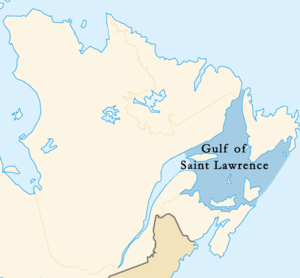Was the Farley Mowat in International Waters?
Paul Watson of the Sea Shepherds is calling it an act of war. The Farley Mowat was seized by teams of “emergency response” mounties deployed in zodiacs from a pair of coast guard ice breakers. Nobody is yet saying exactly where it happened, but apparently they were somewhere in the Cabot Strait, between Cape Breton and Newfoundland. Watson says they were in international waters. The Fisheries Minister, Loyola Hearn, says they were in “internal waters”. That’s a giant difference in interpretation.
So without knowing just exactly where it went down, is either claim reasonable? At the wikipedia level of analysis, the answer is yes.
“Territorial waters” are measured from the low-tide shore baseline 12 nautical miles out to sea. Within it’s territorial waters Canada has legal sovereignty, presumably similar to the legal status of national terrestrial territory. There is an exception requiring free “innocent passage” of vessels, but I doubt if the Farley Mowat could claim they were on a mission of good order and security.
There’s something else called a “contiguous zone” which countries can optionally claim out to 24 nautical miles. Canada does, but it doesn’t seem like it has much serious jurisdiction over that zone.
Here’s what I figure for the territorial waters and contiguous zone of the area, all other things being equal:
By that measure it looks like the Farley Mowat would have had plenty of room for free sailing. Even if they needed to make passage into the Gulf of Saint Lawrence, they could have kept outside of Canadian sovereign terrority.
But as far as I can tell Minister Hearn hasn’t actually been directly quoted using the language of territorial waters. He’s talking “internal waters”. Internal waters are also sovereign territory. The wikipedia definition makes it sound like you pretty much need to inland to be internal. Interestingly, Canada makes a number of exceptional claims to “internal waters” that don’t seem to come even close to fitting that definition. Most controversial at the moment is a chunk of the newly-navigable northwest passage. Also however, the Gulf of Saint Lawrence. Once again, according to wikipedia, the Gulf estuary (the worlds largest estuary!) covers the area between Cape Breton and Newfoundland. By definition, from the looks of it:
It’s worth noting that within internal waters, there’s no right of even innocent passage.
So was the Mowat attacked by mounty pirates when she was boarded, or was it an legitimate arrest? If you accept Canada’s claim that the 1000s of square miles of heaving grey Atlantic in the Cabot Strait are “internal waters”, then it looks like this a purely internal affair. If you’re dubious of that claim, then it gets interesting.
But even if it was a high-seas boarding, it won’t rank as especially crazy on the Canadian-fisheries high-seas boarding scale of craziness. Back in 1995 the Coast Guard forcefully boarded a trawler that wasn’t in internal waters, wasn’t in territorial waters, and wasn’t even in the 200 mile economic zone.
From the federal court record:
“On the 9th of March, 1995, at or about 18:15 (6:15 p.m.)[1], armed boarding parties from three (3) or four (4) Canadian vessels boarded the Spanish deep-sea freezer-trawler ESTAI (the “ESTAI”) within the Northwest Atlantic Fisheries Organization (“NAFO”) Regulatory Area, which is to say outside Canadian fishery waters or, put another way, on the high seas. The boarding parties, which may have included members of a Royal Canadian Mounted Police (“RCMP”) emergency response team, arrested the ESTAI.”
(emphasis added)
From ever-trusty wikipedia:
On March 9 offshore patrol aircraft indicated a likely candidate and several armed DFO offshore fisheries patrol boats, along with Canadian Coast Guard and navy support, pursued the Spanish stern trawler Estai in international waters outside Canada’s 200 nautical mile (370 km) EEZ. The Estai cut its weighted trawl net and fled, resulting in a chase which stretched over several hours and ended only after the Canadian Fisheries Patrol vessel Cape Roger firing of a .50 calibre (12.7 mm) machine gun across the bow of the Estai. The Canadian Coast Guard Ship Sir Wilfred Grenfell used high-pressure fire-fighting water cannons to deter other Spanish fishing vessels from disrupting the enforcement operation. Finally, armed DFO and RCMP officers boarded the vessel in international waters on the Grand Banks and placed it and its crew under arrest.
(emphasis added)

